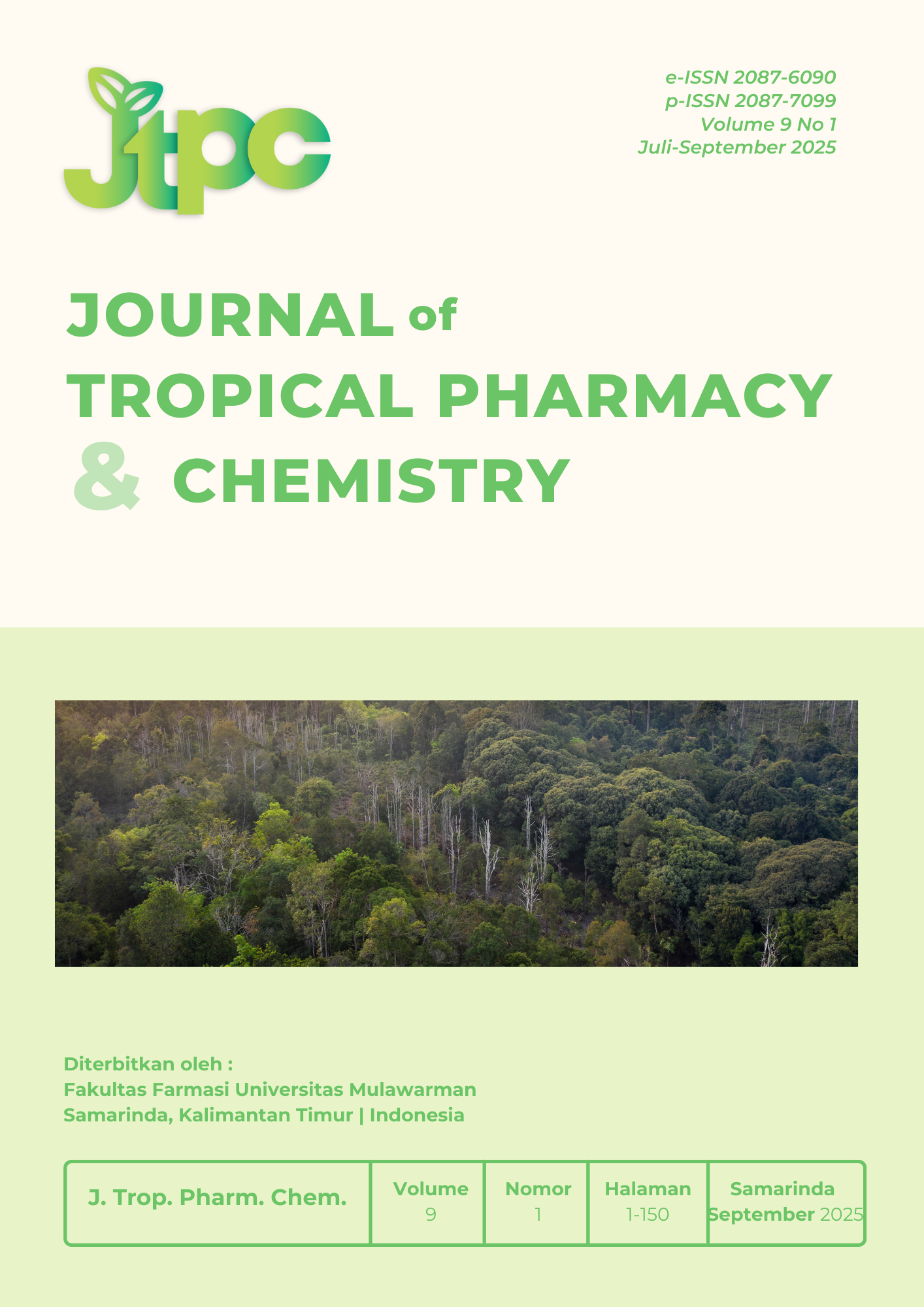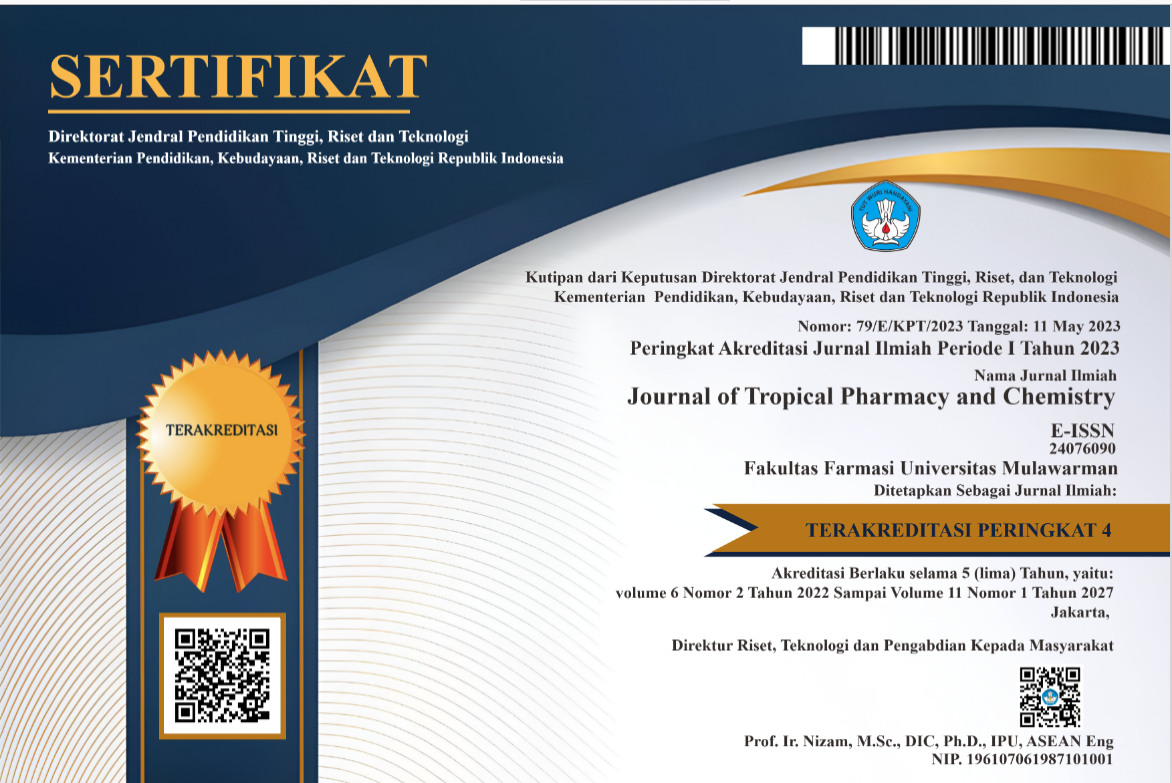Development of a Spirulina-Infused Patch for Oil Control in the T-Zone of face: A Novel Approach to Skin Care.
DOI:
https://doi.org/10.30872/jtpc.v9i1.282Keywords:
Spirulina, T-zone, Algae, Skin care, Anti-acneAbstract
The objective of this research was to develop a spirulina-based patch aimed at regulating sebum production and improving skin health, specifically targeting oiliness in the T-zone region. Spirulina, a blue-green algae rich in antioxidants, anti-inflammatory agents, antimicrobial compounds, and sebum-regulating properties, was selected as the principal active ingredient. The experimental approach involved optimizing a patch formulation for adequate adhesion, flexibility, sustained release of active components, and enhanced oil absorption. Characterization studies were conducted to evaluate mechanical strength, surface pH, moisture retention, elasticity, and user comfort. In vitro studies confirmed the patch’s effectiveness in reducing sebum levels without causing irritation or excessive dryness. Preliminary user trials demonstrated a visible reduction in T-zone oiliness and improvements in skin texture and appearance. The developed patch offers a natural, sustainable, and user-friendly alternative to conventional oil-control products. It provides targeted delivery, minimizes the risk of skin barrier disruption, and enhances skincare efficacy. Further research will focus on long-term performance evaluation and formulation refinements.
Downloads
References
[1] M. Kumar, U. K. Mandal, and S. Mahmood, “Dermatological formulations,” in Dosage Forms, Formulation Developments and Regulations, Elsevier, 2024, pp. 613–642.
[2] G. Kulkarni, A. Abraham, and M. Kulkarni, “Algae-Sourced Bioactives with Promising Applications in Skincare Cosmeceuticals,” pp. 37–45.
[3] H. S. K. M. Lourdes Mourelle, “No Title,” Thalassother. Cosmeceuticals, vol. 2, doi: https://doi.org/10.1201/9781003399285.
[4] S. Knox and N. M. O’Boyle, “Skin lipids in health and disease: A review,” Chem. Phys. Lipids, vol. 236, p. 105055, 2021, doi: https://doi.org/10.1016/j.chemphyslip.2021.105055.
[5] M. Boer, E. Duchnik, R. Maleszka, and M. Marchlewicz, “Structural and biophysical characteristics of human skin in maintaining proper epidermal barrier function,” Postep. Dermatologii i Alergol., vol. 33, no. 1, pp. 1–5, 2016, doi: 10.5114/pdia.2015.48037.
[6] C. Maxim, D. Turcov, A. G. Bulgariu, and D. Șuteu, “Squalene-Background and Perspectives in Cosmeceuticals Formulas,” vol. 70, no. 74, 2024, doi: 10.5281/zenodo.11145431.
[7] I. Sagrafena et al., “Structure and function of skin barrier lipids: Effects of hydration and natural moisturizers in vitro,” Biophys. J., pp. 1–13, 2024, doi: 10.1016/j.bpj.2024.10.006.
[8] M. A. Dias da Rocha et al., “Unveiling the Nuances of Adult Female Acne: A Comprehensive Exploration of Epidemiology, Treatment Modalities, Dermocosmetics, and the Menopausal Influence,” Int. J. Womens. Health, vol. 16, pp. 663–678, 2024, doi: 10.2147/IJWH.S431523.
[9] V. Fu and G. Lu, Skincare Decoded: The Practical Guide to Beautiful Skin. Simon and Schuster, 2021.
[10] K. Miner et al., “Lipid Dysregulation in Sebaceous Gland Disorders and the Impact of Sphingolipid Metabolism on Acne Pathogenesis,” Cureus, vol. 17, no. 4, 2025.
[11] M. Hingankar, J. Mendwade, R. Thakur, S. Mahajan, and P. R. Gahlod, “Skin Aura : The Impact of Moisturizers on Maintaining Skin Hydration,” vol. 8, no. 5, pp. 345–351, 2024.
[12] J. Zdrada, W. Odrzywołek, A. Stolecka-Warzecha, S. Wilczyński, and B. Błońska-Fajfrowska, “The influence of cosmetics dedicated to oily and acne-prone skin on skin parameters,” J. Cosmet. Dermatol., vol. 21, no. 11, pp. 6092–6099, 2022.
[13] A. K. Mohiuddin, “Acne Protection: Measures and Miseries,” Dermatology Clin. Res. DCR, vol. 5, no. 1, pp. 272–311, 2019.
[14] Y. B. Lee, E. J. Byun, and H. S. Kim, “Potential role of the microbiome in acne: A comprehensive review,” J. Clin. Med., vol. 8, no. 7, pp. 1–25, 2019, doi: 10.3390/jcm8070987.
[15] A. Palange, M. Barge, and N. Naikwadi, “Review in Acne Vulgaris along with its treatment,” Asian J. Pharm. Res. Dev., vol. 11, no. 3, pp. 192–196, 2024.
[16] A. Decker and E. M. Graber, “Over-the-counter acne treatments: a review,” J. Clin. Aesthet. Dermatol., vol. 5, no. 5, p. 32, 2012.
[17] H. Ojaniemi, “Developing Consumer Claims in Cosmetic Industry,” no. June, 2024.
[18] L. Talakoub, I. M. Neuhaus, and S. S. Yu, “Antiaging cosmeceuticals,” in International Textbook of Aesthetic Surgery, Springer, 2016, pp. 1183–1209.
[19] N. Nuhii et al., “ADOLESCENTS KNOWLEDGE ON THE USE OF COSMETIC AND DERMATOLOGICAL PREPARATIONS IN THE TREATMENT OF ACNE VULGARIS,” ACTA MEDICA Balk. Int. J. Med. Sci., vol. 9, no. 17–18, pp. 205–214, 2024.
[20] A. A. Almeman, “Evaluating the Efficacy and Safety of Alpha-Hydroxy Acids in Dermatological Practice: A Comprehensive Clinical and Legal Review,” Clin. Cosmet. Investig. Dermatology , vol. 17, pp. 1661–1685, 2024, doi: 10.2147/CCID.S453243.
[21] C. Zhang et al., “Expert consensus on perioperative integrated skincare for noninvasive energy-based device aesthetic procedures in clinical practice in China,” J. Eur. Acad. Dermatology Venereol., 2024.
[22] N. Sampattavanich, N. Chandayani, J. Intarasupht, and A. Nakakes, “An in vivo study to evaluate the influence of oil blotting paper on the efficacy of sunscreen,” Photodermatol. Photoimmunol. & Photomed., vol. 37, no. 4, pp. 324–328, 2021.
[23] E. Woolhiser, N. Keime, A. Patel, I. Weber, M. Adelman, and R. P. Dellavalle, “Nutrition, Obesity, and Seborrheic Dermatitis: Systematic Review,” JMIR dermatology, vol. 7, p. e50143, 2024.
[24] S. M. Mawazi et al., “A review of moisturizers; history, preparation, characterization and applications,” Cosmetics, vol. 9, no. 3, p. 61, 2022.
[25] M. Maarouf, C. L. Maarouf, G. Yosipovitch, and V. Y. Shi, “The impact of stress on epidermal barrier function: an evidence-based review,” Br. J. Dermatol., vol. 181, no. 6, pp. 1129–1137, 2019.
[26] M. Chwil, R. Matraszek-Gawron, P. Terlecka, M. Skoczylas, K. Terlecki, and others, “Comprehensive Review of the Latest Investigations of the Health-Enhancing Effects of Selected Properties of Arthrospira and Spirulina Microalgae on Skin,” Pharmaceuticals, vol. 17, no. 10, p. 1321, 2024.
[27] A. Choopani, M. Poorsoltan, M. Fazilati, A. M. Latifi, and H. Salavati, “Spirulina: a source of gamma-linoleic acid and its applications,” J. Appl. Biotechnol. Reports, vol. 3, no. 4, pp. 483–488, 2016.
[28] A. Durairaj, K. Elumalai, and A. Shanmugam, “Cystic acne treatment: A comprehensive review,” Med. Adv., vol. 1, no. 4, pp. 318–329, 2023.
[29] O. A. Al Hanbali, H. M. S. Khan, M. Sarfraz, M. Arafat, S. Ijaz, and A. Hameed, “Transdermal patches: Design and current approaches to painless drug delivery,” Acta Pharm., vol. 69, no. 2, pp. 197–215, 2019.
[30] J. A. V. Costa, G. M. Barbieri Moro, D. de Moraes Vaz Batista Filgueira, E. Corsini, and T. E. Bertolin, “The potential of spirulina and its bioactive metabolites as ingested agents for skin care,” Ind. Biotechnol., vol. 13, no. 5, pp. 244–252, 2017.
[31] R. J. Giménez Mart’inez et al., “Bioactive Substances and Skin Health: An Integrative Review from a Pharmacy and Nutrition Perspective,” Pharmaceuticals, vol. 18, no. 3, p. 373, 2025.
[32] B. Marjanović et al., “Bioactive Compounds from Spirulina spp.—Nutritional Value, Extraction, and Application in Food Industry,” Separations, vol. 11, no. 9, p. 257, 2024.
[33] A. AN, “EXPLORING THE PRESENCE AND SIGNIFICANCE OF UV-ABSORBING MYCOSPORINE-LIKE AMINO ACID IN ARTHROSPIRA PLATENSIS,” St Teresa’s College (Autonomous), Ernakulam, 2023.
[34] R. Henrikson, “Earth food spirulina,” Laguna Beach, CA Ronore Enterp. Inc, vol. 187, 1989.
[35] A. Kulshreshtha, U. Jarouliya, P. Bhadauriya, G. Prasad, P. S. Bisen, and others, “Spirulina in health care management,” Curr. Pharm. Biotechnol., vol. 9, no. 5, pp. 400–405, 2008.
[36] E. G. Yilmaz, E. Ece, Ö. Erdem, I. Ecs, and F. Inci, “A sustainable solution to skin diseases: ecofriendly transdermal patches,” Pharmaceutics, vol. 15, no. 2, p. 579, 2023.
[37] O. Dumitriu Buzia et al., “Strategies for improving transdermal administration: New approaches to controlled drug release,” Pharmaceutics, vol. 15, no. 4, p. 1183, 2023.
[38] O. S. Kim, “Development of Photoprotective Transdermal Patches for the Controlled-Release of Vitamin C Targeting Acne Vulgaris and Hyperpigmentation,” The Cooper Union for the Advancement of Science and Art, 2024.
[39] T. de J. B. Vieira, “Blood Flow-Parameterized Texture Method for Rendering Facial Expressions,” Universidade do Porto (Portugal), 2017.
[40] N. Tingle and N. Williams, “Hygiene and Skin Integrity,” Essent. Clin. Ski. Nurs., p. 135.
[41] R. W. Murphree, “Impairments in skin integrity,” Nurs Clin North Am, vol. 52, no. 3, pp. 405–417, 2017.
[42] R. Fernandes et al., “Exploring the benefits of phycocyanin: From Spirulina cultivation to its widespread applications,” Pharmaceuticals, vol. 16, no. 4, p. 592, 2023.
[43] O. Shalaby and N. Elsayed, “The Multifaceted Role of Spirulina in Environmental Sustainability: Applications in Aquatic Systems and Ecosystem Management,” Egypt. J. Aquat. Biol. Fish., vol. 29, no. 1, pp. 2631–2652, 2025.
[44] N. U. Parekh, “Evaluation of Protective Effect of C-Phycocyanin against L-Arginine induced Acute Pancreatitis,” Institute of Pharmacy, Nirma University, A’bad, 2022.
[45] S. Trehan, R. Soskind, J. Moraes, V. Puri, and B. Michniak-Kohn, “Natural Products and Stem Cells and Their Commercial Aspects in Cosmetics,” Cosmet. Formul., pp. 221–250, 2019.
[46] I. Oikonomopoulos, T. Perraki, and N. Tougiannidis, “Ftir study of two different lignite lithotypes from neocene achlada lignite deposits in nw greece,” Bull. Geol. Soc. Greece, vol. 43, no. 5, pp. 2284–2293, 2010.
[47] M. Mogale, “Identification and quantification of bacteria associated with cultivated Spirulina and impact of physiological factors,” 2016.
[48] P. Sharma, S. R. Modi, and A. K. Bansal, “Co-processing of hydroxypropyl methylcellulose (HPMC) for improved aqueous dispersibility,” Int. J. Pharm., vol. 485, no. 1–2, pp. 348–356, 2015.
[49] O. A. ElFar et al., “Advances in delivery methods of Arthrospira platensis (spirulina) for enhanced therapeutic outcomes,” Bioengineered, vol. 13, no. 6, pp. 14681–14718, 2022.
[50] S. M. Misicna, R. Tretjakova, S. Kodors, and A. Zavorins, “Lake Zei clay application induced changes in human skin hydration, elasticity, transepidermal water loss and PH in healthy individuals,” Cosmetics, vol. 7, no. 3, p. 51, 2020.
[51] S. Y. Byeon, M. K. Cho, K. H. Shim, H. J. Kim, H. G. Song, and H. S. Shin, “Development of a spirulina extract/alginate-imbedded pcl nanofibrous cosmetic patch,” J. Microbiol. Biotechnol., vol. 27, no. 9, pp. 1657–1663, 2017.
Downloads
Published
Issue
Section
License
Copyright (c) 2025 Minal Narkhede, Yatin Nachan, Sakshi Pande (Author)

This work is licensed under a Creative Commons Attribution-NonCommercial 4.0 International License.




